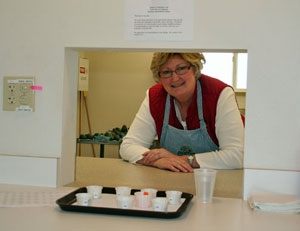Posts Tagged: mandarins
Treat your mandarins right
Mandarins may look like little oranges, but scientists believe that their distinct attributes demand special treatment to maintain a fresh, juicy and tangy character.
“We think the flavor of mandarins declines much more rapidly than oranges,” said Sue Collin (right), a UC Riverside staff research associate who is based at the UC Kearney Agricultural Research and Extension Center in Parlier.
The way oranges are set out at the grocery store or on home counter tops could be trouble for the more delicate mandarin. And when mandarins make a six-week sea voyage to the Pacific Rim, will Asian consumers find the fruit acceptable?
In order to provide farmers, shippers and retailers accurate information about the impact of different storage temperatures on the quality of the fruit, Collin is working with UC Riverside sub-tropical horticulturalist Mary Lu Arpaia and USDA plant physiologist Dave Obenland to understand the changes in mandarins stored at a variety of temperatures, at different humidity levels, for various periods of time.
“A grocery store may be holding fruit at room temperature, 68 degrees or even warmer,” Collin said. “We’re comparing fruit that has been stored in very controlled atmospheres – at temperatures in the 40s, 50s and 60s.”
When it comes to understanding the acceptability of fresh fruit, nothing can match the human palette.
Collin recruits staff based at Kearney to take a break from their jobs to come to a laboratory built at the agricultural research station specifically for sensory testing. The 1,100-square-foot laboratory features neutral white paint and broad-spectrum lighting. The ventilation system was designed to minimize distracting odors. Inside, six tasting booths each have small windows that open to the kitchen area, where samples are prepared.
“We do quite a bit of testing to see if our volunteers can tell the difference in fruit stored at different temperatures,” Collin said.
In conjunction with the human testing, Obenland studies the fruit’s chemical composition to find out if objective numerical values correlate with the more subjective findings of the human tasters.
Although the optimal storage temperature for mandarins is still under investigation, Collin suggested consumers should keep their mandarins in the refrigerator at home for best results.
“I think the flavor holds better and the fruit lasts longer in the refrigerator,” Collin said.
This research is being funded in part by the Citrus Research Board.
Sensory Testing
Tango mandarins are soon to appear in a produce aisle near you
The first commercial crop of an exceptional new mandarin variety created by UC Riverside scientists will be harvested this month.
The fruit, called Tango, is the result of a mutation induced by irradiating budwood of W. Murcott mandarin. The process mimics nature’s manner of improving fruit. Radiation from the sun or natural errors during cell division can cause a single branch or fruit to mutate and develop unique characteristics, which scientists call a “sport.” People have been reproducing favorable sports for generations. In fact, all navel oranges are sports – natural mutations of oranges with seeds or other navel oranges.
W. Murcott mandarins, originally from Morocco, are favored for their deep orange color, easy-peel rind and tangy-sweet flavor. However, when planted within five miles of other seed-bearing citrus – such as Clementine mandarins, lemons or grapefruit – they can be cross-pollinated by bees and become seedy. The Tango maintains the best W. Murcott traits, but because it produces very little viable pollen, it is virtually seedless wherever it is grown.
“This is the most promising mandarin the university has ever produced,” said UC Riverside genetics professor Mikeal Roose.
The Tango mandarin was patented, and registered trees were established by the UC Citrus Clonal Protection Program. Distribution of budwood to citrus nurseries began in June 2006 and was limited exclusively to California growers for one year. Tango was introduced into Florida in 2007 and the trees were available internationally under exclusive licenses in 2009. Tango trees should soon be available to home gardeners through retail nurseries.
In all, 1.6 million Tango trees were sold in California through March 2010.
Tango is not a trademarked name, so the new seedless mandarin will probably be sold under existing grower brand names like Cuties and Delites. Before Christmas, fruit marketed as Cuties and Delites are early ripening Clementine mandarins. Most W. Murcotts and now Tangos will be sold as Cuties and Delites when they ripen in late January, but some Tangos will show up in supermarkets and farmer’s markets under the Tango name.
The Tango was made possible by a UC and citrus industry partnership going back nearly 15 years. Roose and staff research associate Tim Williams began field testing the fruit in 2001. The research and evaluation program was supported by the Citrus Research Board.
“What’s exciting is the parent variety of the Tango is a good piece of fruit,” said Ted Batkin, director of the Citrus Research Board. “It is without a doubt the most widely planted variety that we have released in the past 25 years.”

W. Murcott mandarin (left) and Tango (right).


